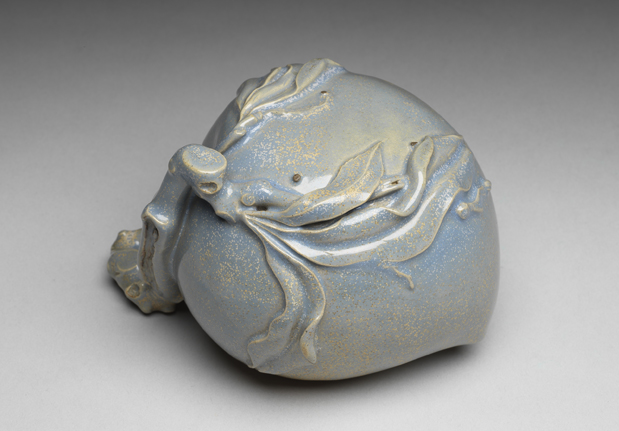Purple-granule peach-shaped water dropper in Jun glaze, Ming to Qing dynasty, 17th–18th century
- Image Number: K1B012024N000000000PAE
- Dynasty: Ming dynasty
- Category: Ceramics
- Function: Stationery
- Material: Minerals/Ceramics/
- Description:
The “Jun Zhou Kiln” recorded in the late Ming Dynasty anthology is famous for its changeable glaze color. In particular, Jun kilns, which were fired in the late 16th century, were mostly made of Yixing sand, and the quality of the burnt products was uneven. The glaze color of this work is similar to the imitation of “Yijun” in the Ming and Qing Dynasties. The shape of the instrument is like a peach fruit, which can also echo the appreciation of ceramics in the late Ming Dynasty. Flat peaches are watered. The fruit is full and hollow. The hole at the tip of the peach is the flow port, clinging to the branches, and the hole at the upper end is the injection port. The whole body is covered with sky blue glaze. At the turning point where the glaze is accumulated, the glaze color is blue, and the surface is covered with yellow and white spots and local stains caused by dust. After careful observation, it can be found that the body of the fruit is engraved with “Longevity and Longevity”, and there are three nail marks at the bottom.

![图片[2]-Purple-granule peach-shaped water dropper in Jun glaze, Ming to Qing dynasty, 17th–18th century-China Archive](https://chinaarchive.net/Ming dynasty/Ceramics/K1B012024N000000000PAE-51595.jpg)
![图片[3]-Purple-granule peach-shaped water dropper in Jun glaze, Ming to Qing dynasty, 17th–18th century-China Archive](https://chinaarchive.net/Ming dynasty/Ceramics/K1B012024N000000000PAE-51596.jpg)
Pictures & Images [HD] download
© Copyright
The copyright of the article belongs to the author, please keep the original link for reprinting.
THE END





